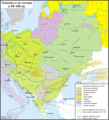ملف:Slav-7-8-obrez.png

حجم البروفه دى: 544 × 599 بكسل. الأبعاد التانيه: 218 × 240 بكسل | 436 × 480 بكسل | 698 × 768 بكسل | 930 × 1,024 بكسل | 1,860 × 2,048 بكسل | 3,051 × 3,359 بكسل.
الصوره الاصليه (3,051 × 3,359 بكسل حجم الفايل: 339 كيلوبايت، نوع MIME: image/png)
تاريخ الفايل
اضغط على الساعه/التاريخ علشان تشوف الفايل زى ما كان فى الوقت ده.
| الساعه / التاريخ | صورة صغيرة | ابعاد | يوزر | تعليق | |
|---|---|---|---|---|---|
| دلوقتي | 15:13، 12 اغسطس 2023 |  | 3,051 × 3,359 (339 كيلوبايت) | Gyalu22 | Reverted to version as of 13:16, 23 October 2022 (UTC) Look at the atlas, don't do your own research |
| 17:43، 1 يونيه 2023 |  | 3,051 × 3,359 (309 كيلوبايت) | Shibbolet3579 | enice was still in the Byzantine Empire at this time. Avars were also present around Vienna and in central Transylvania, evidenced by graves & toponyms. There was a linguistic contact between Albanians and Vlachs, evidenced by the non-Slavic words present in both languages. Placed the Etelköz of the Magyars and the Crimean byzantine Greeks. South-Slavic toponyms (as Trnava for "tip, hillock, mound") evidenced a South-Slavic presence in southern Transylvania. Concerning the Eastern romance spe... | |
| 13:16، 23 اكتوبر 2022 |  | 3,051 × 3,359 (339 كيلوبايت) | Gyalu22 | Reverted bad faith edit, restored to version as of 26 July 2011. The Westermanns Atlas is an irrelevant source for the previous map, as only the Southern Carpathians are shown as possibly inhabited by the Wallachians. | |
| 15:09، 28 ابريل 2014 |  | 3,051 × 3,359 (302 كيلوبايت) | Spiridon Ion Cepleanu | Bulgarian kingdom & east-romance vlachs according with the universitary atlases of history and the Grosser Atlas zur Weltgeschichte, dir. Hans-Erich Stier, Westermann, 1985, ISBN 3-14-10-0919-8, pp. 50, 55-57, 61 & 64. | |
| 18:27، 26 يوليه 2011 |  | 3,051 × 3,359 (339 كيلوبايت) | Koryakov Yuri | The map's resolution is drastically decreased. Undo | |
| 04:53، 26 يوليه 2011 |  | 544 × 599 (329 كيلوبايت) | Spiridon Ion Cepleanu | On the original version of this map, the eastern romance language-spoken populations ("Vlachs" or "Volokhs") are draw only in a little area around Sredets (today Sofia), according with only one of the POVs, called "Röslerian" (since Eduard Robert Rösler | |
| 13:52، 10 مارس 2008 |  | 3,051 × 3,359 (339 كيلوبايت) | Koryakov Yuri | {{Information |Description= |Source= self-made |Date=March 2008 |Author= Koryakov Yuri |other_versions= }} == Licensing == {{self|cc-by-sa-3.0}} Category:Maps of the history of Russia in Russian [[Category:Maps |
استخدام الفايل
استخدام الملف العام
الويكيات التانيه دى بتستخدم الفايل ده:
- الاستخدام ف ar.wikipedia.org
- الاستخدام ف azb.wikipedia.org
- الاستخدام ف ba.wikipedia.org
- الاستخدام ف be-tarask.wikipedia.org
- الاستخدام ف be.wikipedia.org
- الاستخدام ف bg.wikipedia.org
- الاستخدام ف ce.wikipedia.org
- الاستخدام ف cs.wikipedia.org
- الاستخدام ف cv.wikipedia.org
- الاستخدام ف da.wikipedia.org
- الاستخدام ف de.wikipedia.org
- الاستخدام ف en.wikipedia.org
اعرض استخدام عام اكتر للملف ده.

